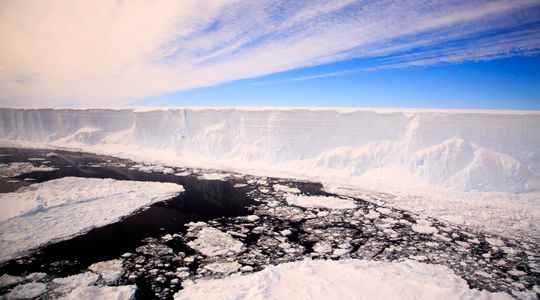A giant iceberg detached from Antarctica in 2017 released more than 150 billion tonnes of fresh water mixed with nutrients as it melted 4,000 km from its starting point, a “huge” volume that could significantly alter an ecosystem fragile, according to a study published Thursday. The formation of icebergs is a natural process, but warming air and oceans are helping to speed it up, scientists say.
In June 2017, this iceberg called A68 separated from a gigantic ice shelf, called Larsen C, at the tip of the Antarctic Peninsula. The trillion-tonne giant, twice the size of Luxembourg, was the largest to ever break away, but has since been downgraded to 6th place, notes the study published in the journal Remote Sensing of Environment. He then remained for two years in the cold waters of the Weddell Sea near the place of his calving (separation) before traveling north, towards warmer seas, then starting his melting until his disappearance in the spring of 2021. in the South Atlantic, near the British island of South Georgia, 4000 km from its starting point.
In the fall of 2020, the iceberg had come dangerously close to this island, raising fears that the block of ice, the submerged part of which still measured some 140 meters, would become stuck on the seabed, blocking the passage of thousands of penguins. and seals inhabiting the area. The disaster had been avoided, but researchers who have followed all the stages of the iceberg’s life via satellites are wondering about the impact of the melting of this freshwater ice.
The equivalent of 61 million Olympic swimming pools
In the three months of 2020-2021 that saw it melt completely near South Georgia Island, the iceberg released a total of 152 billion tons of fresh water mixed with nutrients into this fragile ecosystem. That is the equivalent of 61 million Olympic swimming pools or 20 times Loch Ness, notes in a press release the British Antarctic Survey research center, which participated in the study. “That’s a huge volume of water, and now we want to determine whether it has had a positive or negative impact on the ecosystem around South Georgia,” said study lead author Anne Braakmann- Folgmann, Center for Polar Observation and Modeling.
The study highlights in particular that this volume of water, released into a sea where seals, birds and whales feed, could have affected “the properties of water and plankton”. It is all the more important to study this impact as A68 “has taken a classic path”, notes Anne Braakmann-Folgmann. “We hope to learn more about icebergs taking the same trajectory, and how they influence the polar oceans.”
